 The cherry is the fruit of many plants of the genus Prunus , and is a fleshy drupe (stone fruit). The cherry fruits of commerce are usually obtained from a limited number of species, including especially cultivars of the sweet cherry, Prunus avium . The name 'cherry' also refers to the cherry tree, and is sometimes applied to almonds and visually similar flowering trees in the genus Prunus , as in "ornamental cherry", "cherry blossom", etc. Wild cherry may refer to any of the cherry species growing outside of cultivation, although Prunus avium is often referred to specifically by the name "wild cherry" in the British Isles.
The cherry is the fruit of many plants of the genus Prunus , and is a fleshy drupe (stone fruit). The cherry fruits of commerce are usually obtained from a limited number of species, including especially cultivars of the sweet cherry, Prunus avium . The name 'cherry' also refers to the cherry tree, and is sometimes applied to almonds and visually similar flowering trees in the genus Prunus , as in "ornamental cherry", "cherry blossom", etc. Wild cherry may refer to any of the cherry species growing outside of cultivation, although Prunus avium is often referred to specifically by the name "wild cherry" in the British Isles.Many cherries are members of the subgenus Cerasus , which is distinguished by having the flowers in small corymbs of several together (not singly, nor in racemes ), and by having smooth fruit with only a weak groove or none along one side. The subgenus is native to the temperate regions of the Northern Hemisphere , with two species in America, three in Europe, and the remainder in Asia. Other cherry fruits are members of subgenus Padus. Cherry trees with low exposure to light tend to have a bigger leaf size so they can intercept all light possible. Cherry trees with high exposure to light tend to have thicker leaves to concentrate light and have a higher photosynthetic capacity.
Most eating cherries are derived from either Prunus avium, the sweet cherry (also called the wild cherry ), or from Prunus cerasus , the sour cherry.
The native range of the sweet cherry extends through most of Europe,



